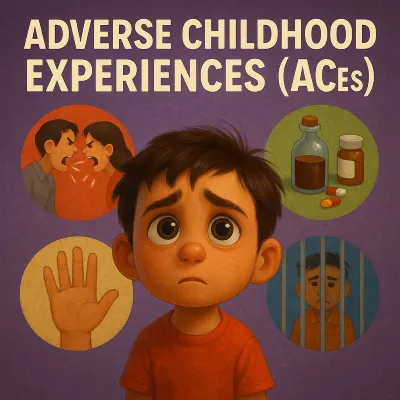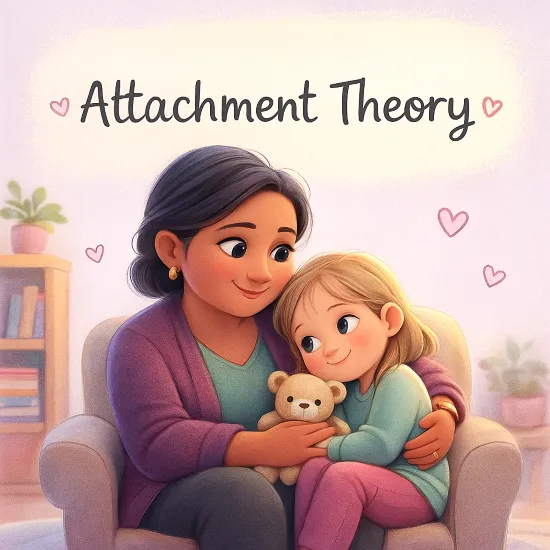Introduction
Setting the Stage: The Prevalence of Childhood Adversity
Childhood should ideally be a time of safety, nurture, and consistent support, providing a foundation for healthy development. However, for a significant number of children, these formative years are marked by challenging and potentially harmful experiences.
Exposure to adversity during childhood is widespread and affects individuals across all socioeconomic strata and geographical regions. Understanding the nature and prevalence of these experiences is essential to grasp their impact on individuals and society as a whole.
The Significance of the ACEs Study
The landmark Adverse Childhood Experiences (ACEs) Study, conducted by the U.S. Centers for Disease Control and Prevention and Kaiser Permanente in the 1990s, fundamentally altered the understanding of the long-term effects of childhood trauma.
This large-scale research involving over 17,000 participants demonstrated a powerful link between various forms of childhood adversity and negative health outcomes in adulthood. The study established that these experiences are not isolated events but rather potent factors that can profoundly influence an individual's health and well-being across the lifespan (Brenas, Shin and Shaban-Nejad, 2019; Hussaini et al., 2016; Campbell, 2020; Pletcher et al., 2019).
The findings have since been replicated and expanded upon by numerous subsequent studies globally (Witt et al., 2019; Lee, Kim and Bhang, 2020; Witt et al., 2019).
What are Adverse Childhood Experiences (ACEs)?
Common Types of ACEs

The original ACE Study identified ten specific categories of adverse experiences occurring before the age of 18. These were grouped into two main areas: household dysfunction and child maltreatment (Venkatesan and Akindolie, 2018).
- Abuse:
- Physical abuse
- Emotional abuse
- Sexual abuse
- Neglect:
- Physical neglect
- Emotional neglect
- Household Dysfunction:
- Witnessing domestic violence
- Living with household members who had a mental illness
- Living with household members who had substance use issues
- Living with household members who had been incarcerated
- Parental separation or divorce
These categories provided a framework for quantifying the cumulative exposure to adversity during a child's formative years (Purswani, Marsicek and Amankwah, 2020).
Expanding the Scope: Other Forms of Childhood Trauma
While the original ten categories from the ACE Study remain foundational, research and clinical practice have broadened the understanding of childhood adversity to include a wider array of potentially traumatic experiences.
These can encompass community violence, historical trauma, experiences of discrimination, bullying, frequent relocation, and the stress associated with significant poverty (Walsh et al., 2019; Hughes and Tucker, 2018).
These additional adversities also significantly impact a child's development and long-term outcomes, contributing to the overall burden of trauma.
Defining the 'Adverse' Experience
An experience is considered 'adverse' in this context because it involves a real or perceived threat to the child's safety, security, or physical and emotional integrity (Guidetti et al., 2023).
These events are typically beyond the child's control and can overwhelm their capacity to cope, particularly when they are chronic or occur within the child's own home environment, often perpetrated by or involving caregivers (Guidetti et al., 2023).
The 'adverse' nature lies in the potential for these experiences to disrupt normal developmental processes and create lasting vulnerabilities.
Impact of ACEs on Child Development

The Physiological Stress Response: Toxic Stress
When a child experiences adversity, their body activates the stress response system, releasing hormones like cortisol. In a safe environment, this system returns to baseline once the threat passes. However, chronic or severe adversity, especially without adequate protective relationships, can lead to prolonged activation of this system, resulting in 'toxic stress'.
Toxic stress is a persistent state of elevated physiological arousal that can disrupt the developing brain and body systems (Jacob et al., 2018; Wade et al., 2019; Kimple and Kansagra, 2018). This differs from 'positive' stress (brief, mild, normal part of development) or 'tolerable' stress (more serious but buffered by supportive relationships).
Neurobiological Impacts: Brain Development and Function
The developing brain is particularly vulnerable to the effects of toxic stress. Chronic exposure to stress hormones can alter the architecture and function of key brain regions involved in fear, memory, stress response, and executive function.
These include the amygdala (involved in processing fear and threat), the hippocampus (involved in memory and learning), and the prefrontal cortex (involved in planning, decision-making, and emotional regulation) (Guidetti et al., 2023).
Research indicates that children exposed to ACEs may show impaired prefrontal cortex functioning (Guidetti et al., 2023), potentially affecting cognitive and behavioural control. These neurobiological changes can create a foundation for difficulties later in life (Guidetti et al., 2023).
Emotional Regulation, Attachment, and Behaviour
Adversity in childhood profoundly impacts emotional development. Children who experience ACEs may struggle with emotional regulation, finding it difficult to manage intense feelings like anger, sadness, or anxiety (Guidetti et al., 2023).
Secure attachment to caregivers is crucial for a child's sense of safety and ability to explore the world. Adversity, especially neglect or abuse, can disrupt attachment patterns, leading to difficulties forming secure relationships later on.
These challenges in emotional regulation and attachment can manifest as various behavioural issues, including aggression, oppositionality, anxiety, withdrawal, and difficulties with attention and hyperactivity (Jimenez et al., 2016; Guidetti et al., 2023).
For example, some trauma-related symptoms in children can overlap with ADHD symptomatology, making differential diagnosis challenging (Guidetti et al., 2023).
ACEs and Adult Outcomes: A Lifelong Connection
Physical Health Risks: Chronic Illnesses and Disease
The physiological changes triggered by toxic stress in childhood have significant long-term consequences for physical health. Adults with a history of ACEs face a higher risk of developing a range of chronic illnesses and diseases (Guidetti et al., 2023; Hussaini et al., 2016; Wade et al., 2019).
These include cardiovascular disease, stroke, certain types of cancer, diabetes, obesity, chronic respiratory illnesses, and autoimmune disorders (Hussaini et al., 2016; Wade et al., 2019).
The enduring impact on stress response systems, inflammation pathways, and immune function contributes to this increased vulnerability across the life course (Brenas, Shin and Shaban-Nejad, 2019).
Mental Health Challenges, Substance Use, and Addiction
ACEs are strong predictors of a wide spectrum of mental health conditions in adulthood. These include depression, anxiety disorders, post-traumatic stress disorder (PTSD), personality disorders, and an increased risk of psychosis (Karatekin, 2017; Kosteletos, Kollias and Stefanis, 2020; Cheong et al., 2017).
The difficulties with emotional regulation and coping strategies developed in response to childhood trauma can also increase susceptibility to substance use and addiction. Studies indicate that a significant proportion of substance use problems may trace back to ACEs, with a dose-response relationship observed for multiple adverse events (Tilson, 2018; Hussaini et al., 2016; Sordi and Hauck, 2015).
Furthermore, the literature points to a complex relationship between ACEs and conditions like ADHD, where trauma-related symptoms can sometimes be mistaken for ADHD or potentially contribute to its persistence into adulthood (Guidetti et al., 2023).
Social Functioning, Relationships, and Economic Stability
The impact of ACEs extends beyond physical and mental health, influencing social functioning, the ability to form and maintain healthy relationships, and economic stability.
Early attachment difficulties and challenges with emotional regulation can affect interpersonal skills and trust, potentially leading to difficulties in intimate relationships, friendships, and professional interactions.
A history of ACEs is also associated with reduced educational attainment, lower income, unemployment, and increased involvement with the criminal justice system (Heirigs, no date; Larkin and Park, 2012; Santaularia et al., 2020).
These factors can perpetuate cycles of adversity across generations.
The Cumulative Burden: Risks Associated with Multiple ACEs

Understanding the Dose-Response Relationship Explained
A critical finding of the original ACE Study and subsequent research is the clear dose-response relationship between the number of ACEs experienced and the risk of negative outcomes (Hussaini et al., 2016; Witt et al., 2019; Jimenez et al., 2016).
This means that as the number of adverse experiences increases, so does the likelihood and severity of physical health problems, mental health disorders, substance use issues, and difficulties in social and economic functioning (Witt et al., 2019).
While even one ACE can have an impact, experiencing multiple ACEs significantly elevates the risk profile (Witt et al., 2019; Jimenez et al., 2016). The ACE score serves as a simple metric reflecting this cumulative burden, demonstrating that the impact is not merely additive but often synergistic, creating complex challenges.
Compounding Vulnerabilities and Complex Needs
Experiencing multiple ACEs compounds vulnerabilities across multiple domains – biological, psychological, and social. A child exposed to abuse, neglect, and household dysfunction, for instance, faces heightened risks for dysregulated stress systems, impaired brain development, emotional difficulties, and strained relationships simultaneously.
This creates a complex web of needs that can be challenging to address. Individuals with high ACE scores often present with multiple co-occurring physical and mental health conditions, requiring integrated and comprehensive support services (Larkin and Park, 2012).
The interaction between different types of adversity can exacerbate their individual effects, making the overall impact greater than the sum of its parts.
Intergenerational Transmission of ACEs
Adverse childhood experiences can also be transmitted across generations. Parents who experienced ACEs may face ongoing challenges with mental health, substance use, or relationship difficulties, which can, in turn, affect their parenting capacity and create adverse environments for their own children.
Research indicates a strong association between parental ACEs and current child adversity (Randell, O’Malley and Dowd, 2015). This intergenerational cycle underscores the need for interventions that support not only individuals with a history of ACEs but also families and communities, addressing the root causes and breaking the pattern of transmission (Shah et al., 2020).
Supporting Children Affected by ACEs
Understanding Resilience: Buffering Adversity
Resilience refers to the ability to withstand, adapt to, and recover from adversity (Wolfe et al., 2019; Wekerle, 2020; Hughes, Ford and Bellis, 2018; Beutel et al., 2017). It is not simply bouncing back but rather a dynamic process influenced by internal strengths and external protective factors.
Key protective factors include supportive relationships with caring adults (both within and outside the family), developing self-regulation skills, positive beliefs about the self, and engaging in activities that foster competence and connection, such as sports or community participation (Hughes, Ford and Bellis, 2018; Traub and Boynton-Jarrett, 2017).
Resilience can buffer the negative effects of ACEs, although it may not entirely eliminate the associated harms, particularly with high levels of adversity (Beutel et al., 2017; Hughes, Ford and Bellis, 2018). Nurturing resilience in children and adults is a vital strategy for mitigating the impact of past trauma (Wolfe et al., 2019).
Therapeutic Approaches and Support Systems
Effective interventions for individuals affected by ACEs often involve trauma-informed care, which recognizes the widespread impact of trauma and integrates this knowledge into practices and policies (Guidetti et al., 2023; Brenas, Shin and Shaban-Nejad, 2019).
Therapeutic approaches like Eye Movement Desensitisation and Reprocessing (EMDR) have shown effectiveness in processing traumatic memories and reducing associated symptoms (Guidetti et al., 2023). Counselling, cognitive behavioural therapy (CBT), and attachment-based therapies can help individuals develop coping skills, regulate emotions, and build healthier relationships.
Support systems, including family, friends, peer support groups, and community organisations, provide crucial resources and reduce feelings of isolation.
Interventions that enhance social support are particularly beneficial, especially for individuals with poor perceived social support (Cheong et al., 2017).
Preventing ACEs: Community and Policy Strategies
Preventing ACEs from occurring in the first place is the most effective long-term strategy. This requires a multi-faceted approach involving community and policy-level interventions. Strategies include promoting safe, stable, and nurturing relationships for children and families, strengthening economic support for families (addressing the link between poverty and ACEs) (Walsh et al., 2019; Hughes and Tucker, 2018), and creating protective community environments.
Policy initiatives can focus on early childhood education, parenting support programmes, mental health services, and addressing systemic issues like poverty, discrimination, and lack of access to healthcare.
Screening for ACEs in clinical and school settings is increasingly supported as a means for early identification and intervention (Campbell, 2020). Building trauma-informed communities where individuals feel safe, connected, and supported is fundamental to preventing adversity and fostering well-being for future generations.
Conclusion
Summarising the Profound Influence of ACEs
Adverse Childhood Experiences represent a significant public health challenge with widespread and lasting consequences. The evidence, beginning with the original ACE Study, clearly demonstrates how various forms of childhood adversity can disrupt healthy development, altering physiological stress responses and brain architecture.
These early experiences are strongly linked to an increased risk of numerous physical health problems, mental health disorders, substance use issues, and difficulties in social functioning throughout adulthood.
The cumulative burden of multiple ACEs presents a particularly elevated risk, highlighting a clear dose-response relationship. Understanding this profound influence is crucial for developing effective strategies to address the root causes of many health and social problems.
Looking Ahead: Hope and Action
Despite the significant challenges posed by ACEs, the growing understanding of their impact also brings hope and a clear call to action. Resilience research demonstrates that individuals can and do overcome adversity, particularly when supported by protective factors and relationships.
Effective therapeutic interventions and trauma-informed care approaches offer pathways to healing and recovery. Most importantly, prevention efforts at the community and policy levels can reduce exposure to ACEs and create environments where children can thrive.
Addressing adverse childhood experiences requires a collective societal effort, moving beyond individual blame to systemic solutions that prioritise the safety, well-being, and healthy development of all children.
By investing in prevention, early intervention, and comprehensive support systems, it is possible to mitigate the lifelong impact of ACEs and build healthier, more resilient communities.


